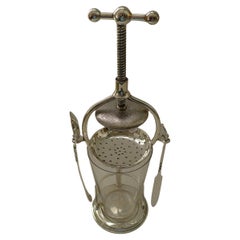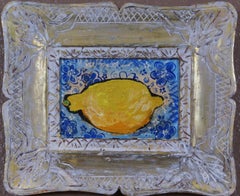Henry Lemon
Victorian Lemon Squeezer in Silver Plated Dated 1868
By Henry Wilkinson & Co.
Located in Bath, GB
A stunning antique English lemon squeezer made from silver plate and fully marked on the underside
Category
Antique Mid-19th Century British Victorian Barware
Materials
Silver Plate
$2,312 Sale Price
20% Off
H 11 in W 4.5 in D 4.5 in
Recent Sales
Oil Painting by Henry Maurice Page "Lemons and Grapes"
By Henry Maurice Page
Located in Mere, GB
Oil Painting by Henry Maurice Page "Lemons and Grapes" flourished 1845 -1908 Painter of rural
Category
19th Century Still-life Paintings
Materials
Oil
H 16 in W 18 in D 2 in
Lemon
Located in Storrs, CT
Oil on masonite of a lemon. The painting is accompanied by the book, "Color Photographs" by the
Category
Mid-20th Century Modern Still-life Paintings
Materials
Oil
People Also Browsed
French 17th Century Baptismal Font
Located in Round Top, TX
A very beautiful 17th century Baptismal Font from the South of France beautifully carved from marble. Minimalist lines give this piece a calming feel. Will serve wonderfully as a bir...
Category
Antique 17th Century French Garden Ornaments
Materials
Marble
Art Deco Table or Desk Top Brass Mounted 7" Double Convex Magnifying Glass
Located in Chapel Hill, NC
Art Deco desk/table top adjustable magnifying glass. A 7" diameter double convex lens in an open topped brass frame suspended between two vertical posts rising from a stepped two-tie...
Category
Early 20th Century American Art Deco Scientific Instruments
Materials
Brass
$3,950
H 14.75 in W 13 in D 3.38 in
Asprey Londoner Trolley, Black Cross Hatch Suitcase
By Asprey International Limited
Located in West Palm Beach, FL
Asprey Londoner tolley, 30" black cross hatch suitcase, handstitched black saddle hide leather corner and handle, palladium finished metal accessories, signature Asprey locks with tw...
Category
21st Century and Contemporary English Modern Trunks and Luggage
Materials
Chrome
Goose Feather Hand Fan
Located in Pueblo, CO
Beautiful Victorian goose plume hand fan in perfect condition. This fan is perfect for use, or in costume, or display piece, put into a shadowbox frame. Wood handle with metal strun...
Category
Antique Late 19th Century American Victorian Collectible Jewelry
Materials
Feathers
Vintage Ocean Rolling Chair Co. Inc. Boardwalk Cart: A Timeless Seaside Treasure
Located in New York, NY
Step back in time with this fun Early 20th Century Wicker Boardwalk rolling cart crafted by the renowned "Ocean Rolling Chair Co. Inc," as evidenced by delicately placed porcelain si...
Category
Early 20th Century American Other Historical Memorabilia
Materials
Rattan
$10,000 / set
H 67.5 in W 44.5 in D 68.5 in
1900's Large Victorian Shop Display Cabinet with Bow Glass Sides
Located in Saint-Ouen, FR
This late 19th to early 20th Century bow fronted shop display cabinet with double doors, and four adjustable internal shelves over a plinth base, is really spectacular. Its glass she...
Category
Antique 1890s British Victorian Cabinets
Materials
Wood
$24,019
H 95.28 in W 82.68 in D 17.72 in
Exquisite Albino Peacock Taxidermy: A Majestic Display of Rarity and Elegance
Located in New York, NY
This magnificent taxidermy specimen showcases an albino (leucistic) peacock, skillfully mounted on an oval wooden base. The intricate details of the peacock's unique coloring are cap...
Category
21st Century and Contemporary American Late Victorian Taxidermy
Materials
Feathers
$4,600 / item
H 72 in W 14 in D 8 in
Antique Gothic Revival Top Quality Hand Carved & Gilt Wooden Church Wall Bracket
Located in Lisse, NL
Deeply carved, extra large size, Gothic Revival corbel, bracket with a stunning patina.
Finding unique antiques that have just that little bit more than your average is what we alwa...
Category
Early 20th Century European Gothic Revival Religious Items
Materials
Wood, Pine
$3,843
H 20.4 in W 32.1 in D 18.3 in
Tiffany & Co. Sterling Silver Mid-Century Modern Cocktail or Brandy Pitcher
By Tiffany & Co.
Located in Philadelphia, PA
A fine cocktail or brandy pitcher.
In sterling silver.
By Tiffany and Co.
The body with tapered sides and a spout for pouring supported by a trumpet form foot.
Fully hallmarked f...
Category
Mid-20th Century Mid-Century Modern Barware
Materials
Sterling Silver
Impressive Antique Hand Carved Oak Gothic Revival Door Complete with Wall Frame
Located in Lisse, NL
Stunning Gothic architectural door with strong iron hardware in original frame.
This striking and all hand carved door was originally probably part of a church or monastery and the ...
Category
Antique 19th Century European Gothic Revival Doors and Gates
Materials
Iron
$16,213
H 109 in W 52.6 in D 8 in
Large Jade Sphere
Located in New York, NY
This impressive polished Jade Sphere from Afghanistan is a true embodiment of natural beauty and expert craftsmanship. Measuring an impressive 16 inches in diameter and weighing appr...
Category
2010s Afghan Natural Specimens
Materials
Jade
Big Art Deco Column , 1930, French
Located in Ciudad Autónoma Buenos Aires, C
Column Art Deco
Year: 1930
Country: French
We have specialized in the sale of Art Deco and Art Nouveau and Vintage styles since 1982. If you have any questions we are at your dispos...
Category
Vintage 1930s French Art Deco Pedestals and Columns
Materials
Wood
Through the Lens: 19th Century Standing Magnifying Glass
Located in New York, NY
A beautifully crafted 19th-century standing magnifying glass, featuring a circular lens mounted within an elegant, square wooden frame. The frame is supported by four turned spindles...
Category
Antique 19th Century French Napoleon III Scientific Instruments
Materials
Glass, Wood
Art Deco Black Alligator Suitcase
By America Pedro P. Diaz 1
Located in Westport, CT
Art Deco black alligator suitcase with original satin lining and straps. Chrome hardware and original label. America Pedro P Diaz Arequipa De Peru.
Category
Early 20th Century Peruvian Art Deco Trunks and Luggage
Materials
Animal Skin, Fabric, Scrap Wood
Antique Working English Cast Iron Cheese Press Thomas Corbett of Shrewsbury 1880
Located in Portland, OR
A rare antique and all original fully functioning cast iron English cheese press, by Thomas Corbett of Shrewsbury, circa 1880. This cheese press has just been fully professionally re...
Category
Antique 1880s English Industrial Scientific Instruments
Materials
Iron
$3,680 Sale Price
20% Off
H 82 in W 23.75 in D 21.75 in
Large Set of 8 Vintage Lab Sieves, English, Brass, Stacking, Scientific, C.1965
Located in Hele, Devon, GB
This is a large set of 8 vintage laboratory sieves. An English, brass stacking scientific apparatus, dating to the mid 20th century, circa 1965.
Fascinating set with superb period a...
Category
Mid-20th Century British Mid-Century Modern Scientific Instruments
Materials
Brass
$1,653
H 16.34 in Dm 8.47 in
Get Updated with New Arrivals
Save "Henry Lemon", and we’ll notify you when there are new listings in this category.
Henry Lemon For Sale on 1stDibs
On 1stDibs, you can find the most appropriate henry lemon for your needs in our varied inventory. Find abstract versions now, or shop for abstract creations for a more modern example of these cherished works. Finding the perfect henry lemon may mean sifting through those created during different time periods — you can find an early version that dates to the 19th Century and a newer variation that were made as recently as the 21st Century. On 1stDibs, the right henry lemon is waiting for you and the choices span a range of colors that includes gray, white, beige and red. A henry lemon from (after) Henri Matisse, Henri Matisse, Anthony Benjamin, David Halliday and Nathaniel Currier — each of whom created distinctive versions of this kind of work — is worth considering. Artworks like these — often created in lithograph, archival paper and paper — can elevate any room of your home.
How Much is a Henry Lemon?
The average selling price for a henry lemon we offer is $1,758, while they’re typically $1,200 on the low end and $56,651 for the highest priced.
More Ways To Browse
Perrier Jouet Glasses
Pewter Goblets
Pewter Stirrup Cups
Pink Fenton
Ralph Lauren Barware
Rizzo Willy Photography
Rohac Screw
S S Normandie
Selangor Pewter
Silver Band Highball Glasses
Skyscraper Cocktail Shaker
Sottsass Apple
Sterling Silver Stirrer
Swiss Hans Turnwald
Tommi Parzinger Ice Bucket
Tulip Champagne Glass
Used Beverage Dispenser
Vintage and Antique Copper Cups

